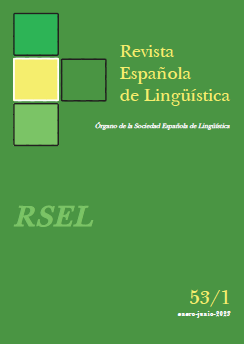Metonymy in the use of determiners and indefinite quantifiers in Spanish. Descriptive approach and didactic application for the Spanish as foreign/second language classroom
doi: https://doi.org/10.31810/rsel.53.1.4
Keywords:
determiners; metonymy; Cognitive-Grammar; Spanish-as-a-foreign-languageAbstract
This paper analyses what kinds of metonymy are implied in the usage of definite and indefinite determiners in Spanish. It also assesses how can the conceptualization of determiners systems be improved by developing learners’ awareness of metonymic links between the different values of these forms and the constructions they take part in.
The distinction between generic references values (Un médico debe ser empático ‘A doctor must be empathic’), non-specific values (Necesitamos un médico ‘We need a doctor’) and specific values (Pediré cita a un médico que me recomendaron ‘I will request an appointment for a doctor that was recommended to me) of articles and some quantifiers will be discussed, as well as the quantifying interpretation of definite determiners in cases such as ¡No sabes los amigos que tiene Laura! ‘You don’t know the friends Laura has’, meaning ‘You don’t know (you can’t imagine) how many friends Laura has’. The use of the typical iconic notations of Cognitive Grammar (Langacker), and likewise of others theoretical tools of this model such as the profile/base alignment, among others, will allow to consider metonymy as a kind of construal.
Regarding the didactic application, we will explore the advantages of the cognitive approach combined with a variety of exercises and conceptualization strategies in tasks of presentation and practice of different determiners.
Downloads
References
Alhmoud, Z., A. Castañeda Castro y T. Cadierno (2019). Construcciones comparativas. Aproximación descriptiva y didáctica desde la gramática cognitiva, en I. Ibarretxe-Antuñano, T. Cadierno y A. Castañeda Castro (eds.), Lingüística cognitiva y español LE/L2, pp.189-219. Londres/Nueva York: Routledge.
Alonso Raya, R., A. Castañeda Castro, P. Martínez Gila, L. Miquel, J. Ortega Olivares, J. P. Ruiz Campillo (2021). Gramática básica del estudiante de español. Barcelona: Difusión.
Barcelona, A. (2013). Metonymy is not just a lexical phenomenon. On the operation of metonymy in grammar and discourse, en J. Niels-Lennart and D. C. Minugh (eds.), Selected Papers from the Stockholm Metaphor Festival, pp.13-46. Estocolmo: Acta Universitatis Stockholmiensis.
Castañeda Castro, A. (2004). Potencial pedagógico de la gramática cognitiva: Pautas para la elaboración de una gramática pedagógica del español/LE, RedELE. Última consulta: 8 de diciembre de 2022. www.mecd.gob.es/dctm/redele/Material-RedEle/Revista/2004_00/2004_redELE_0_06Castaneda.pdf?documentId=0901e72b80e0c73e
Castañeda Castro, A. (coord.) (2014). Enseñanza de gramática avanzada de ELE. Criterios y recursos. Madrid: SGEL.
Castañeda Castro, A. (2019). Lingüística cognitiva, en J. Muñoz Bassols, E. Gironzetti y M. Lacorte (eds.), The Routledge handbook of Spanish language teaching: metodología, recursos y contextos para la enseñanza del español L2, pp. 261-278. Londres/Nueva York: Routledge.
Castañeda Castro, A. y M. D. Chamorro Guerrero (2014). Determinantes y cuantificadores del nombre. Problemas descriptivos y propuestas didácticas, en A. Castañeda Castro (coord.), Enseñanza de gramática avanzada de ELE. Criterios y recursos, pp. 179-22. Madrid: SGEL.
Castañeda Castro, A. y A. Sánchez Cuadrado (2021). The role of metonymy in teaching the Spanish verbal system to L2/FL learners. Círculo de Lingüística Aplicada a la Comunicación 87: 71-94
Coseriu, E. (1962). Determinación y entorno, en Teoría del lenguaje y lingüística general. Cinco estudios. Madrid: Gredos.
García Mayo, M.ª P. y R. Hawkins (eds.) (2009). Second language acquisition of articles. Ámsterdam/Filadelfia: John Benjamins.
Ibarretxe-Antuñano, I., T. Cadierno y A. Castañeda Castro (eds.). (2019). Lingüística cognitiva y español LE/L2. Londres/Nueva York: Routledge.
Instituto Cervantes (2007). Plan curricular del Instituto Cervantes. Niveles de referencia para el español. Madrid: Editorial Biblioteca Nueva.
Hawkins, J. A. (1978). Definiteness and Indefiniteness: A Study in Reference and Grammaticality Prediction. Londres: Croom Helm.
Laca, B. (1999). La presencia y ausencia de determinante, en I. Bosque y V. Demonte (eds.) Gramática descriptiva de la lengua española I, pp. 891-928. Madrid: RAE / Espasa Calpe.
Langacker, R. W. (1987). Foundations of Cognitive Grammar. Volume I. Theoretical prerequisites. Stanford: Stanford University Press.
Langacker, R. W. (1991). Foundations of Cognitive Grammar. Volume II. Descriptive application. Stanford: Stanford University Press.
Langacker, R. W. (2000). Grammar and conceptualization. Berlín: Mouton de Gruyter.
Langacker, R. W. (2001). Cognitive Linguistics, language pedagogy and the English present tense, en M. Pütz, S. Niemeier y R. Dirven (eds.), Applied Cognitive Linguistics Volume (I): Theory and acquisition, pp. 3-40. Berlín/ Nueva York: Mouton De Gruyter.
Langacker, R. W. (2008). Cognitive Grammar: A basic introduction. Nueva York: Oxford University Press.
Langacker, R. W. (2009). Metonymic grammar, en K.U. Panther, L. Thornburg y A. Barcelona (eds.). Metonymy and metaphor in grammar, pp. 45-74. Ámsterdam/Filadelfia: John Benjamins.
Leonetti, M. (1999a). Los determinantes. Madrid: Arco libros.
Leonetti, M. (1999b). Los cuantificadores. Madrid: Arco libros.
Montero Gálvez, S. (2019). Una aproximación cognitiva al valor referencial y cuantificador de los artículos, en I. Ibarretxe-Antuñano, T. Cadierno y A. Castañeda Castro (eds.), Lingüística cognitiva y español LE/L2, pp. 73-94. Londres/Nueva York: Routledge.
Morimoto, Y. (2011). El artículo en español. Madrid: Castalia.
Panther, K.U. y L. Thornburg (2017). Metaphor and metonymy in language and thought: A Cognitive Linguistics approach. Synthesis Philosophica 64.2, pp. 271-294.
Panther, K.U., L. Thornburg y A. Barcelona (eds.) (2009). Metonymy and metaphor in grammar. Ámsterdam/Filadelphia: John Benjamins.
Radden, G. (2009). Generic reference in English: A metonymic and conceptual blending analysis, en K.-U. Panther, L. Thornburg y A. Barcelona (eds.), Metonymy and metaphor in grammar, pp. 199-298. Ámsterdam/Filadelfia: John Benjamins.
Radden, G. y R. Dirven (2007). Cognitive English grammar. Ámsterdam/Filadelfia: John Benjamins.
Real Academia Española y Asociación de Academias de la Lengua Española (2009). Nueva gramática de la lengua española. Madrid: Espasa Calpe.
Ruiz de Mendoza, F. J. (2000). The role of mappings and domains in understanding metonymy, en A. Barcelona (ed.), Metaphor and metonymy at the crossroads, pp. 109-132. Berlín/Nueva York: Mouton de Gruyter.
Ruiz de Mendoza, F. J. y L. Pérez Hernández (2001). Metonymy in the grammar: motivation, constraints and interaction. Language and Communication 21, pp. 321-357.
Published
How to Cite
Issue
Section
Copyright (c) 2023 Revista Española de Lingüística

This work is licensed under a Creative Commons Attribution-NonCommercial-NoDerivatives 4.0 International License.











